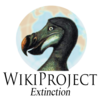| This article is rated Start-class on Wikipedia's content assessment scale. It is of interest to the following WikiProjects: | |||||||||||||||||||||||||||||||||||||||||
| |||||||||||||||||||||||||||||||||||||||||
Untitled
editEncyclopedia Mythica have quite a different description... http://www.pantheon.org/articles/r/reem.html Hpmons 14:11, 7 April 2007 (UTC)
so does harry potter. magical beasts and where to find them. 23:40, 18 February 2009 (UTC)68.3.191.130 (talk)
and i quote
" Extremely rare giant oxen with golden hides, the Re'em are found both in the wilds of North America and the Far East. Re'em blood gives the drinker immense stregnth, though the diffuculty of procuring it means that supplies are neligible, and rarley for sale on the open market. "
from Fantistic Beasts & Where to Find Them, by J.K. Rowling
21:05, 23 February 2009 (UTC)68.3.191.130 (talk)
- None of Rowling's work is a good reference for real mythology. She made up quite a bit in order to "liven up" the material she used. 97.104.210.67 (talk) 03:37, 25 April 2009 (UTC)
The quotations in this page are truly excessive. It probably borders on copyright infringement. If someone familiar with the material could condense it dramatically that would be ideal. Locke9k (talk) 19:59, 15 June 2009 (UTC)
At the very least, something in this article should actually mention its incredible size, instead of just "sometimes it's translated as unicorn" and that's it. —Preceding unsigned comment added by 75.73.70.113 (talk) 04:48, 24 January 2011 (UTC)
Oryx?
editIs there an actual cite for the idea that the Arabian Oryx was the re'em? I've never seen anything reputable suggest anything other than a wild ox (presumably the aurochs). 165.91.174.184 (talk) 04:18, 5 September 2009 (UTC)
- Oops, that was me. In any case, the Arabian Oryx doesn't fit the description in any way except having horns, since it is small, unaggressive, and not remarkably strong - whereas the re'em is described in ways that suggest it was thought of as the strongest of all animals ("he [God] hath as it were the strength of a re'em [Numbers 24:8], "wilt thou trust him, because his strength is great" [Job 39:11]) and an aggressive creature. Furthermore, it is listed alongside cattle in Psalm 26:9, Isaiah 34:7, and Deuteronomy 33:17. The reference is clearly to the aurochs, and there ought to be some way to find a cite to demonstrate this...Vultur (talk) 04:28, 5 September 2009 (UTC)
- I'm also dubious of the Oryx claim since the horns of this animal point backwards, whereas most depictions in art have it forward. Scubatoad (talk) 17:03, 9 November 2024 (UTC)
Psalm 22
editI don't know how to edit wikipedia articles so i write here. I don't have any sources to back this up, but i just noticed a structure pattern in the psalm/song number 22 (ps 22) which supports the idea that the word re'em means "wild ox". Psalm 22 use the same hebrew word (re'em) translated to "unicorn" in KJV in Ps 22:21. In that same psalm, in verse 12, it says even in KJV "Many bulls have compassed me: strong bulls of Bashan have beset me round.". The land of Bashan was a territory east of the Jordan, north of Gilead. It was wellknown for its large animals and its cattle (Num 32:1,4). Deu 32:14 speaks of "rams of Bashan" and Amos 4:1 speaks of the "cows of Bashan". Since psalm 22 mention the bulls and the wild ox in the same psalm its likely that the psalmist is speaking about the same animal in both verse 12 and 21. It's strongly supported by the context: in verse 12 the psalmist say he is surrounded and encircled by the bulls (=their gender). In verse 21 he asks to be protected from the horns of the wild ox (=the animal). And again, same pattern, almost same verses: In verse 13 the psalmist says lions are roaring, and in verse 21 he prays to be saved from the mouth of the lions. This rythm in the poem/psalm should not be ignored. One has to ignore the rythm of the poem/psalm to put a unicorn in there. — Preceding unsigned comment added by 83.252.122.173 (talk) 08:57, 4 February 2014 (UTC)
Attributing the substitution to "Christian scholars" who wrote the KJV is not correct. The Hebrew word re'em was translated monokeros (unicorn) in the Septuagint. In 1899, Johann Ulrich Duerst wrote that the re’em was most likely the aurochs or urus (Bos primigenius), an extinct species of cattle that once ranged through the Middle East, North Africa, Europe, India, and Asia. The aurochs was about a third larger than domestic cattle, and stood over six feet tall at the shoulder. According to several accounts, the animal was murderously aggressive. It's likely that the aurochs had been extinct in Egypt for at least two hundred years at the time of the Septuagint translation, so the Jewish scholars substituted another fierce grazing animal, the Indian rhinoceros, that was described in an exaggerated style by the Greek physician and historian Ctesias around 400 BCE in his writings on India. — Preceding unsigned comment added by 70.36.159.66 (talk) 05:03, 2 May 2016 (UTC)
- If either of you finds reliable sources for this stuff, and if it seems appropriate, I'd be happy to do the edits for you. Alephb (talk) 17:25, 9 March 2017 (UTC)
Fixed incorrect wording of Bible
editI have undone this edit which "fixed" the allegedly "incorrect" wording of the KJV. We quote what the source says, not what we think it should say. This edit made the article both incorrect and nonsensical.
I agree that the KJV is wrong in its translation (and on many other points too, see my version of The Lord's Prayer). But that's not the point here.
When we quote it, we say exactly what it does say. And in this case, what it does say is the whole point of the section. Andrewa (talk) 15:29, 26 December 2020 (UTC)



